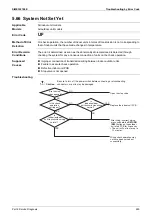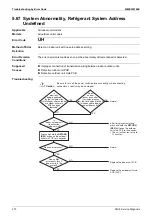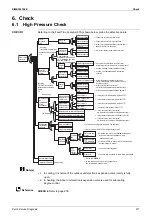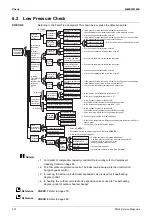
Check
SiME332106E
272
Part 6 Service Diagnosis
Note(s)
Reference
Reference
6.2 Low Pressure Check
CHECK 2
Referring to the Fault Tree Analysis (FTA) shown below, probe the defective points
CHECK 7
Refer to page 279.
CHECK 8
Refer to page 280.
Abnormal drop in
low pressure
(Low evaporating
temperature)
[In cooling]
(
1)
Defective
low pressure
control
Defective
compressor
capacity
control
Defective low pressure
sensor
Defective main PCB
Defective
low pressure
protection
control
Defective low pressure
sensor
Defective hot gas EV
Defective main PCB
[In both cooling
and heating]
(
2)
[In cooling]
If the indoor unit
electronic
expansion valve is
throttled too much:
(
3)
Defective indoor
unit electronic
expansion valve
Defective valve coil
Defective valve body
Defective
control
Defective gas pipe
thermistor of indoor unit
Defective liquid pipe
thermistor of indoor unit
Defective main PCB
Defective outdoor
unit electronic
expansion valve
Defective valve coil
Defective valve body
[In heating]
If the outdoor unit
electronic
expansion valve
excessively
throttled:
(
4)
Defective
control
Defective low pressure
sensor
Defective suction pipe
thermistor
Defective main PCB
[In cooling]
Low suction air
temperature of
the evaporator
[In heating]
Low suction air
temperature of
indoor unit
Short circuit
Low room temperature
Defective suction air thermistor of indoor unit
Low suction air temperature of outdoor unit
Defective outdoor air temperature thermistor of outdoor unit
High pipe
resistance
Abnormal piping length
Bent or crashed pipe
Clogging of foreign materials
Stop valve closed
Less
circulation
quantity of
refrigerant
Degradation
in evaporating
capacity
Refrigerant shortage
Moisture choke
Dirty evaporator
Decreased
airflow rate
Decreased
fan output
Defective fan motor
Is there any obstacle in the airflow passage?
Defective main PCB
(Including capacity setting)
High
airflow
passage
resistance
Dirty filter
Obstacle
Defective electronic
expansion valve
control
Are the coil resistance and insulation normal?
Check for the thermistor resistance and connection.
Check for the thermistor resistance and connection.
Are the voltage characteristics normal?
Are the coil resistance and insulation normal?
Is the pressure value checked with the Service Checker corresponding
to the measurement value of the pressure sensor?
Check for the thermistor resistance and connection.
Is the suction air temperature less than 14°C?
Is the room temperature less than 14°C?
Eliminate moisture by vacuum operation. (Refer to
CHECK 8.
)
Is the pressure value checked with the Service Checker
corresponding to the measurement value of the pressure sensor?
Are the voltage characteristics normal?
Is the pressure value checked with the Service Checker corresponding
to the measurement value of the pressure sensor?
Are the voltage characteristics normal?
Can the fan motor be rotated with hands?
Are the motor coil resistance and insulation normal?
Is the air filter clogged?
If a spare PCB is mounted, is the
capacity setting properly made?
Is the heat exchanger clogged?
Refer to
CHECK 7.
Does the piping length fall in the permissible range?
Conduct visual checks for pipe conditions.
Is there any temperature difference caused before and after the filter or
branch pipe?
Check to be sure the stop valve is open.
Is the connector properly connected?
Are the thermistor resistance characteristics normal?
Is the outdoor air temperature less than –20°C?
Is the connector properly connected?
Are the thermistor resistance characteristics normal?
Defective valve coil
Defective valve body
Are the coil resistance and insulation normal?
1. For details of compressor capacity control while in cooling refer to Compressor
Capacity Control on page 56.
2. The “low pressure protection control” includes low pressure protection control and
hot gas bypass control.
3. In cooling, the indoor unit electronic expansion valve is used for “superheating
degree control”.
4. In heating, the outdoor unit electronic expansion valve is used for “superheating
degree control of outdoor heat exchanger”.
















































